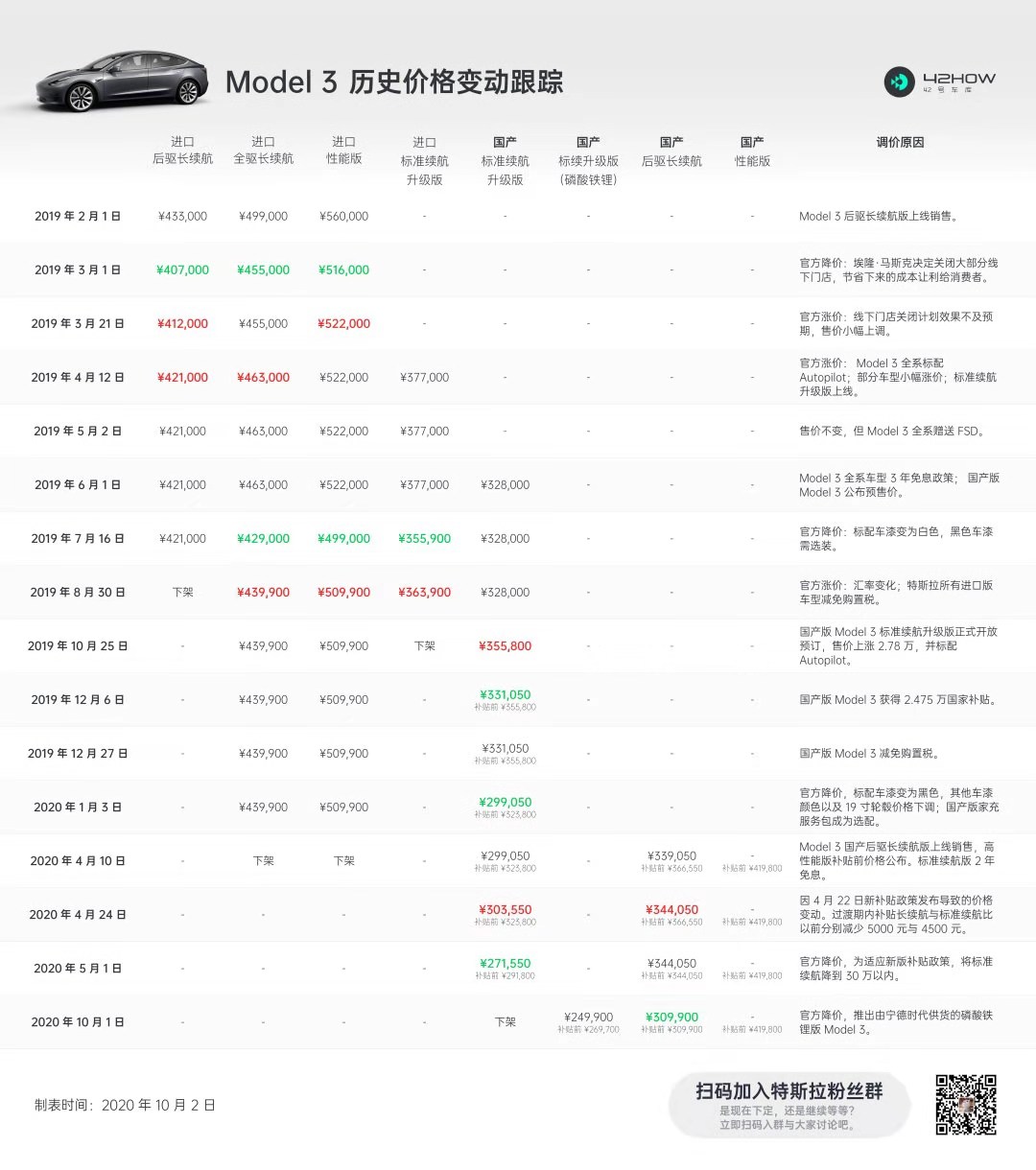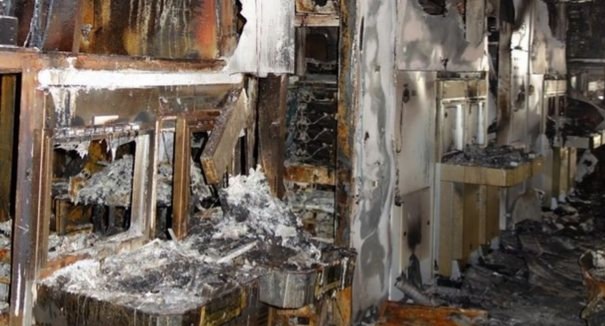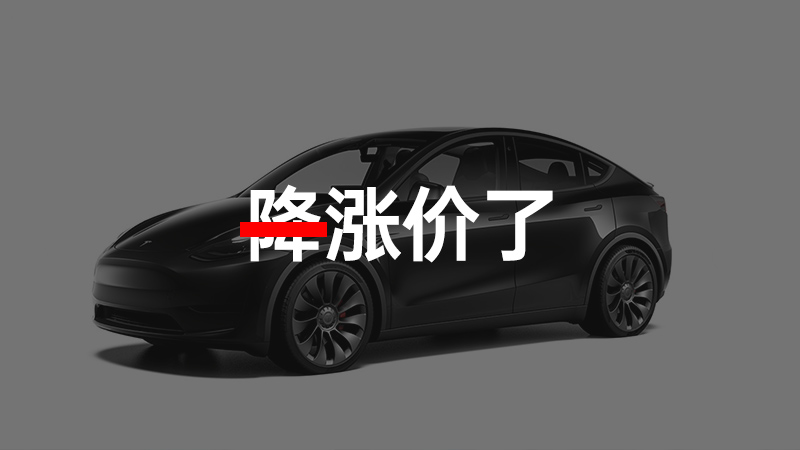On March 24th, 2021, Tesla’s official website adjusted the prices of the locally-produced Model Y vehicles. The prices of the existing long-range all-wheel-drive and performance version Model Y have both increased by 8,000 RMB.
Soon after the website update, Tao Lin posted on Weibo saying, “Customers who have already placed orders will not be affected by this price adjustment.”
Many were surprised by Tesla’s price increase, as the company has always been known for its price cuts. However, what you may not know is that this is already the 6th official price increase from Tesla since Model 3/Y entered the Chinese market.
Tesla’s price fluctuations: not just price cuts
A look back at 6 price increases
On February 1st, 2019, Tesla Model 3 was launched and sold in China. The first official price cut occurred a month later, on March 1st. Musk explained that Tesla decided to close most of its offline stores, saving costs to pass on to consumers.
However, just 20 days later, the company announced that the cost-saving measures of closing stores did not meet expectations, and thus, Tesla had its first price increase.
Shortly after on April 12th, 2019, the Model 3 for sale in China had its second price increase. The reason for the increase was due to the Autopilot basic version being included as standard. However, this price increase was relatively lower compared to the price for the optional Autopilot configuration before, so it could be considered a “clear increase but hidden price cut.”
On July 16th, 2019, Tesla had its second official price cut, making white paint a standard and black an optional color. On August 30th, 2019, Tesla had its third price increase, due to the fluctuation of the exchange rate.
The fourth price increase was on October 25th, 2019. The locally-produced Model 3 standard range increased version was officially launched for sale, and it came with basic Autopilot as standard. Compared to the pre-sale price, the price rose by RMB 27,800, but it was still RMB 8,100 cheaper than the imported version on that day.
On April 22nd, 2020, under the new energy policy, the subsidy amount was lowered. The subsidy for the locally-produced long-range rear-wheel-drive version was reduced by RMB 5,000, and the subsidy for the standard range increased version was reduced by RMB 4,500. Tesla followed the subsidy adjustment in a one-to-one proportion, and had its fifth price increase.
Today, the Model Y has experienced its sixth official price increase, rising by 8,000.
Existing customers are not affected by the price increase, except for the following changes
While Tesla has stated that existing customers will not be affected by the price changes, this statement comes with a caveat: as long as the order is not modified.
“Not modifying” includes not only changing the vehicle type between the long-range all-wheel drive version and the performance version, but also changing the configurations of the same vehicle type. On the Model Y, these configurations include:
- Paint color
- Wheels
- Interior color
- Autopilot configuration

In other words, if you ordered a Model Y before today and now want to make any changes to the above four configurations, the car price will be calculated based on today’s updated price, which is 8,000 yuan more expensive. Whether this is worth it depends on individual preferences.
Why the increase and when will it be reduced
What caused the price increase
On February 21, 2021, Tesla USA adjusted the price of the Model Y, with the high-performance version increasing by $1,000 and the long-range all-wheel drive version decreasing by $1,000. The standard and performance versions of the Model 3 were reduced by $1,000.
However, in less than a month, Tesla raised the price of the long-range all-wheel drive version by $1,000 in March, returning to its price before the February reduction. On the same day, the standard-range upgrade and long-range all-wheel drive versions of the Model 3 on the US website also increased by $500.
Tesla did not provide an official explanation for these price adjustments, and the reasons for the price reductions can be relatively easy to speculate: the cost of manufacturing Tesla vehicles has decreased since the redesigned Model 3/Y models entered mass production.
As for the reasons for the price increase, when combined with the overall trend in the automotive industry during this time period, a certain cause can be identified: a shortage of automotive components, particularly chips, resulting in supply not meeting demand, which leads to price increases.

The situation is getting worse as one of the world’s largest semiconductor chip manufacturers, Renesas Electronics in Japan, reported a factory fire on March 21, which might severely impact the supply chain with an expected one-month recovery time.
Volkswagen believes the chip shortage in Q1 will cause a loss of 100,000 car sales for them this year, while Ford pointed out that the shortage of components has affected the production of several popular models, including their flagship pickup truck F-150. The shortage might result in losses of between $1 billion and $2.5 billion in profits for Ford this year.
The impact of the shortage is not limited to Volkswagen and Ford but has affected the whole automotive industry, including Tesla; there is a high possibility that the price increase has been influenced by this factor.
Regarding Tesla’s price fluctuations, the Model 3, which has been officially launched in China for some time, has undergone seven price cuts, with the first batch of the performance version priced at less than 340,000 yuan, which is around 600,000 yuan including the purchase tax. This process has led to Tesla being labeled as a “leek cutting machine.” Many potential buyers are hesitant to make a purchase due to concerns that prices might decrease soon after buying.
When analyzing Tesla’s price cuts, we can see that the pace of cutting prices for domestically produced Tesla models has slowed down, and with the increasing domestic production rate, there will be less room for further price cuts.
In terms of the Model Y, apart from cost reductions brought by increased production efficiency, we should consider whether there are any key parts that could help to reduce its cost. Currently, the two versions of the Model Y still use LG’s ternary lithium battery, and due to the range requirements, they are unlikely to switch to lithium iron phosphate batteries, where cost reduction is more difficult.
However, looking at the recently released Ministry of Industry and Information Technology (MIIT) information, both the Model Y and the performance version of the Model 3 are equipped with domestically produced Tesla motors, which should bring some cost reductions. Another aspect to look forward to is the two upcoming versions of the Model Y, the long-range rear-wheel drive version and the standard range upgrade version, which have not yet been launched.Lower prices for lower-spec models are to be expected, and the standard-range upgraded version may use lithium iron phosphate due to lower range requirements, resulting in a price of around 280,000 yuan for this vehicle based on a price difference of 30,000 yuan between the Model 3 and the Model Y Performance. The long-range rear-wheel-drive Model Y may cost around 310,000 yuan. Of course, if the problem of auto parts shortages is resolved within the next few months, there may be a small price correction for these price-adjusted models.
In conclusion
No one wants to buy a car and then see its value drop rapidly, especially for electric vehicles that depreciate even faster in the second-hand market. Tesla’s significant price reductions over the past two years, as well as its localization efforts, have greatly helped it to expand its user base to what it is today, but it has also caused frustration among many owners. Under the spotlight of rising prices for Model Y, people are most concerned about when the next price reduction will occur.
In the current market, Tesla may be the most active automotive company when it comes to price adjustments, with direct sales combined with official price adjustments. Compared to traditional dealership models, there is almost no buffer, whether it’s a price increase or decrease. Although consumers have different opinions on this issue, efficiency is the core goal for Tesla, and this mode has become a marketing label for Tesla.
What impact will the price increase of 8,000 yuan have on the sales of the Model Y?
One month before the delivery date of the Model Y on the official website in China, it was already scheduled to Q2. Before the production capacity is fully utilized, the sales of Model Y in the short term are mainly accumulated orders, and this impact is difficult to observe. Moreover, before a strong competitor enters the market, Model Y, even with an 8,000 yuan price increase, is still the first choice for most people to buy a pure electric vehicle at this price point.
However, Tesla’s public image has visibly declined and deviated from the right track due to a series of issues ranging from user rights protection, public relations errors, to banning entry into government agencies after experiencing several such incidents recently.
Compared to the price increase of Model Y, this may have the greatest impact on Tesla’s sales and even the more long-lasting effect.
This article is a translation by ChatGPT of a Chinese report from 42HOW. If you have any questions about it, please email bd@42how.com.
